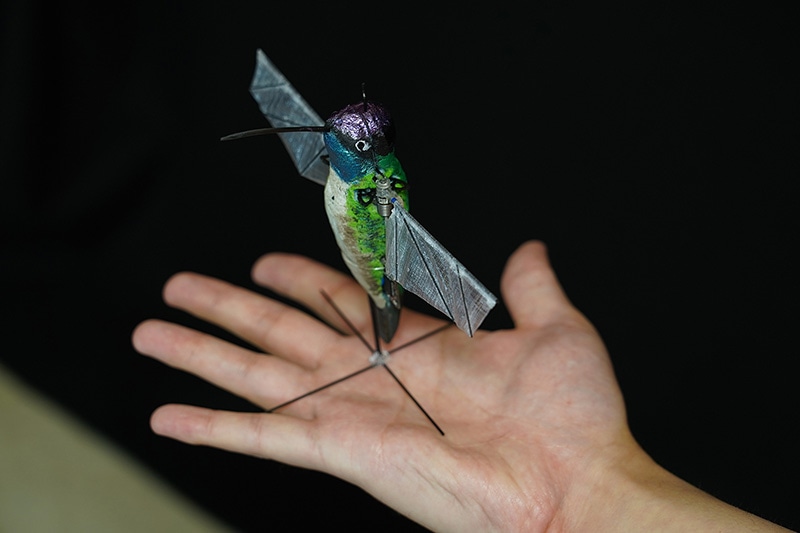May 10 2019
Hummingbirds can not only fly like a bird but also hover like an insect. If drones had this combination, they would be able to move better through collapsed buildings and other chaotic spaces to locate trapped victims.
 Purdue University researchers are building robotic hummingbirds that learn from computer simulations how to fly like a real hummingbird does. The robot is encased in a decorative shell. (image credit: Purdue University photo/Jared Pike)
Purdue University researchers are building robotic hummingbirds that learn from computer simulations how to fly like a real hummingbird does. The robot is encased in a decorative shell. (image credit: Purdue University photo/Jared Pike)
Scientists at Purdue University have built flying robots that act like hummingbirds, trained by machine learning algorithms based on many methods the bird uses naturally on a daily basis.
The robot after learning from a simulation “knows” how to maneuver around on its own like a hummingbird would, such as deducing when to perform an escape maneuver.
Artificial intelligence, integrated with flexible flapping wings, also permits the robot to teach itself new tricks. Even though the robot cannot see yet, for instance, it senses by feeling surfaces. Each touch changes an electrical current, which the scientists understood they could track.
The robot can essentially create a map without seeing its surroundings. This could be helpful in a situation when the robot might be searching for victims in a dark place – and it means one less sensor to add when we do give the robot the ability to see.
Xinyan Deng, Associate Professor of Mechanical Engineering, Purdue University
On May 20th at the 2019 IEEE International Conference on Robotics and Automation in Montreal, the scientists will be presenting their work.
Drones cannot be made substantially smaller, because of the way conventional aerodynamics work. They would not be able to produce sufficient lift to support their weight.
But hummingbirds do not apply conventional aerodynamics – and their wings are strong. “The physics is simply different; the aerodynamics is inherently unsteady, with high angles of attack and high lift. This makes it possible for smaller, flying animals to exist, and also possible for us to scale down flapping wing robots,” Deng said.
Scientists have been attempting for years to decipher hummingbird flight so that robots can fly where bigger aircraft cannot. In 2011, the company AeroVironment, commissioned by DARPA, an agency within the U.S. Department of Defense, assembled a robotic hummingbird that was heavier than a real one but not as quick, with helicopter-like flight controls and narrow maneuverability. It needed a human to remote control it at all times.
Deng’s team and her collaborators looked at hummingbirds themselves for many summers in Montana. They recorded critical hummingbird maneuvers, such as making a swift 180-degree turn, and converted them to computer algorithms that the robot could learn from when linked to a simulation.
Further research on the physics of hummingbirds and insects enabled Purdue scientists to construct robots smaller than hummingbirds – and even as tiny as insects – without sacrificing the way they fly. The smaller the size, the greater the wing flapping frequency, and the more resourcefully they fly, Deng says.
The robots comprise of 3D-printed bodies, laser-cut membranes, and wings made of carbon fiber. The scientists have created one hummingbird robot weighing 12 g – the weight of the average adult Magnificent Hummingbird – and another insect-sized robot weighing 1 g. The hummingbird robot can lift over its own weight, up to 27 g.
Engineering their robots with higher lift gives the scientists more wiggle room to ultimately incorporate a battery and sensing technology, such as a GPS or camera. Currently, the robot needs to be fastened to an energy source while it flies – but that will not be for much longer, the team says.
The robots could fly noiselessly similar to hummingbirds in nature, making them more ideal for undercover operations. Also, they remain steady through turbulence, which the scientists showed by testing the dynamically scaled wings in an oil tank.
The robot requires just two motors and can manipulate each wing autonomously of the other, which is how flying animals perform extremely agile maneuvers in nature.
An actual hummingbird has multiple groups of muscles to do power and steering strokes, but a robot should be as light as possible, so that you have maximum performance on minimal weight.
Xinyan Deng, Associate Professor of Mechanical Engineering, Purdue University
Robotic hummingbirds would not only aid in search-and-rescue missions, but also enable biologists to more reliably examine hummingbirds in their natural settings through the senses of a realistic robot.
“We learned from biology to build the robot, and now biological discoveries can happen with extra help from robots,” Deng said.
Primary stages of the work, including the Montana hummingbird experiments in partnership with Bret Tobalske’s group at the University of Montana, were monetarily supported by the National Science Foundation.
This work is in line with Purdue's Giant Leaps celebration, recognizing the university’s global progress made in AI, algorithms and automation as part of Purdue’s 150th anniversary. This is one of the four themes of the yearlong celebration’s Ideas Festival, designed to promote Purdue as an intellectual center solving real-world matters.
Hummingbird Robots: Naturally Intriguing
Credit: Jared Pike, communications specialist for Purdue University’s School of Mechanical Engineering